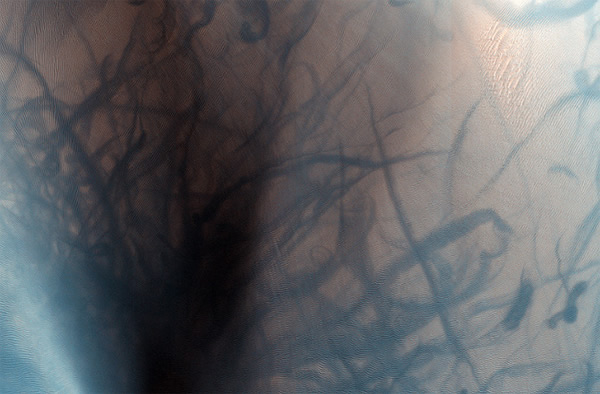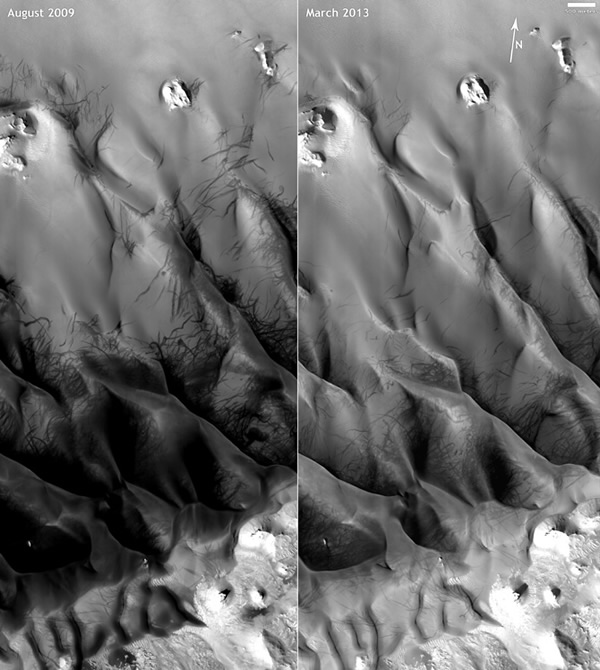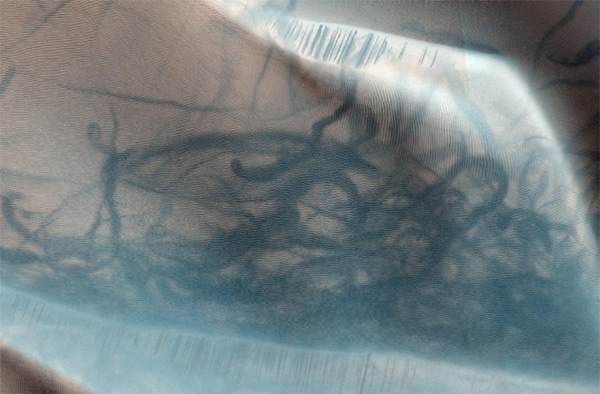Dust Devils Rip Up Mars' 'Etch A Sketch' Surface
Dust devils are a well-known atmospheric phenomena on Mars, and as these new observations show, the devilish vorticies can carve beautiful patterns in the Martian dust.
What's more -- in side-by-side comparisons of observations of the same Mars region years apart -- it appears that the active Mars atmosphere acts like an Etch A Sketch, rubbing out the dust devils' tracks, only for the dust devils to make brand new tracks years later.
Imaged by the ever-impressive High-Resolution Imaging Science Experiment (HiRISE) camera aboard NASA's Mars Reconnaissance Orbiter (MRO), these dust devil tracks were spotted meandering over the Nili Fossae region of the Red Planet's surface.
Detail of dust devil tracks in the Nili Fossae region of Mars as imaged by the HiRISE camera in March 2013.
Dust devils on Mars form in a similar way to their terrestrial counterparts: warm air near the surface rises into cooler air above. If the conditions are right, the pocket of air will begin to rotate and contract, forming small whirlwinds sometimes reaching hundreds of meters into the atmosphere.
These whirling dervishes pick up the top layers of Martian dust as they travel, uncovering the darker layers beneath. The contrast of dark dust devil tracks and light upper dusting makes the tracks easily highlighted for the high-resolution optics of HiRISE.
Side by side comparison of the same region (nearly four years apart) of Nili Fossae as imaged by the HiRISE camera. The dark lines are dust devil tracks.
The advantage of having a long-duration satellite in orbit around Mars is that detailed comparisons can be image of the same location years apart (as shown above). Nili Fossae has undergone obvious changes from 2009 to 2013; previous dust devil tracks have been erased and totally new tracks have taken their place.
"This tells us that there has been at least one dust storm since then to erase the old tracks, and lots of dust devil activity to create the new ones," writes Corwin Atwood-Stone, graduate student of the Lunar and Planetary Laboratory at the University of Arizona -- the department that manages the HiRISE mission.
Detail of dust devil tracks in the Nili Fossae region of Mars as imaged by the HiRISE camera in March 2013. Streaks of fallen material down slopes are also shown.
In addition to the Etch A Sketch-like removal of dark tracks, HiRISE has spotted linear features scoured down slopes of dunes interjecting the curved dust devil tracks (pictured above). And, like the dust devil tracks, these linear downflows are erased over time and new ones form years later.
All these features in the Mars regolith are indicative of a highly dynamic Martian atmosphere that is continuously shaping the surface, providing HiRISE with a smorgasbord of interesting landscapes that have atmospheric phenomena leaving their mark, often in beautiful, elegant ways.(May 16, 2013 02:51 PM ET // by Ian O'Neill)














